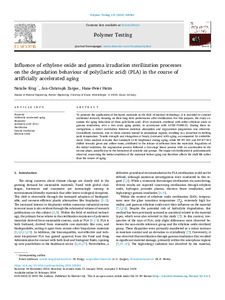| dc.date.accessioned | 2024-02-28T11:08:15Z | |
| dc.date.available | 2024-02-28T11:08:15Z | |
| dc.date.issued | 2024-02-10 | |
| dc.identifier | doi:10.17170/kobra-202402209617 | |
| dc.identifier.uri | http://hdl.handle.net/123456789/15506 | |
| dc.language.iso | eng | |
| dc.rights | Namensnennung 4.0 International | * |
| dc.rights.uri | http://creativecommons.org/licenses/by/4.0/ | * |
| dc.subject | artificially accelerated aging | eng |
| dc.subject | bioplastics | eng |
| dc.subject | poly(lactic-acid) (PLA) | eng |
| dc.subject | sterilization | eng |
| dc.subject | Gamma irradiation | eng |
| dc.subject | ethylene oxide | eng |
| dc.subject.ddc | 600 | |
| dc.subject.ddc | 660 | |
| dc.title | Influence of ethylene oxide and gamma irradiation sterilization processes on the degradation behaviour of poly(lactic acid) (PLA) in the course of artificially accelerated aging | eng |
| dc.type | Aufsatz | |
| dcterms.abstract | To promote the application of bio-based materials in the field of medical technology, it is essential to conduct additional research, focusing on their long-term performance after sterilization. For this purpose, the study examines the aging behaviour of three poly(lactic-acid) (PLA) materials, sterilized with either ethylene oxide or gamma irradiation, over a two years aging period, in accordance with ASTM F1980-21. During these investigations, a direct correlation between moisture absorption and degradation progression was observed. Crystallinity increased, due to chain scission mainly in amorphous regions, resulting in a reduction in melting peak temperature. Tensile strength and elongation at break, decreased with aging, accompanied by embrittlement. Color analysis revealed that Luminy® L130 brightened during aging, while NP HT 202 and NP HT 203 shifted towards green and yellow tones, attributed to the release of softeners from the materials. Regardless of the initial condition, the degradation process followed a two-stage linear process with an acceleration in the second phase, possibly due to the formation of catalytic end groups. The impact of sterilization is predominantly observed concerning the initial condition of the materials before aging and therefore affects the shelf life rather than the course of aging. | eng |
| dcterms.accessRights | open access | |
| dcterms.creator | Krug, Natalie | |
| dcterms.creator | Zarges, Jan-Christoph | |
| dcterms.creator | Heim, Hans-Peter | |
| dc.relation.doi | doi:10.1016/j.polymertesting.2024.108362 | |
| dc.subject.swd | Alterung | ger |
| dc.subject.swd | Biokunststoff | ger |
| dc.subject.swd | Polymilchsäure | ger |
| dc.subject.swd | Sterilisation <Hygiene> | ger |
| dc.subject.swd | Gammabestrahlung | ger |
| dc.subject.swd | Ethylenoxid | ger |
| dc.subject.swd | Degradation <Technik> | ger |
| dc.type.version | publishedVersion | |
| dcterms.source.identifier | eissn:1873-2348 | |
| dcterms.source.journal | Polymer Testing | eng |
| dcterms.source.volume | Volume 132 | |
| kup.iskup | false | |
| dcterms.source.articlenumber | 108362 | |


